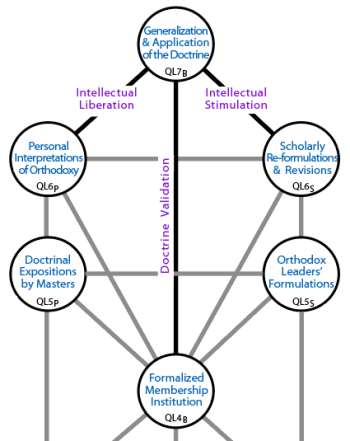Modifying the Orthodoxy: L6 & L7
L6: Authorized Revisions
Doctrines and their formulations need following close scrutiny of existing texts, evolution of the social context, additional uses, and contributions from the realizations of thoughtful adherents. These revisions get evaluated, accepted, approved and informally authorized in a process of publication, lectures, discussions that involve the wider adherent body.
Staunchly conservative adherents with limited mental flexibility may be unwilling to accept changes. However, it is only to be expected that by standing on the shoulders of the Founder's insights, that is to say by taking for granted what their predecessors have worked so hard to appreciate, later scholars should be able to see further and deeper.
Centres
Dynamic Duality: Revisions may involve scholarly penetration of a topic with coverage of past analyses and leading to a reconfiguration of a theme or a re-orientation of basic principles. Such work is on behalf of the school as a whole i.e. it is social.
However, revisions also occur in a personal way that is less disciplined way. Because each adherent brings unique experiences and aspirations, each needs to formulate doctrines for themselves so as to develop their own personal understanding of the orthodox doctrine. Every adherent claims to support the orthodoxy via such understanding, even if some might judge it deviant or incorrect.
So this level in the Tree will generate two polarized but connected Centres:
and .
is labeled
is labeled
may be challenged, but they carry more weight than . So the social pole is dominant and placed on the right in the Tree.
Psychosocial Pressure ![]() :
:
Channels
The two L6 Centres naturally interact and influence each other. Because aims to be useful and modern, adherents who try to take it on board while remaining orthodox end up making their own P in order to feel comfortable. While of current doctrine typically lack comprehensiveness and even strict logical coherence, they may be genuine, worthwhile and interesting, and can then stimulate .

Channel is labeled Doctrinal Evolution.
L6 ↔ L5
will generally be viewed sceptically as potentially undermining the doctrine's fundamentals. So any supported revision of the doctrine affects guardianship responsibilities. Again, there are 4 possible channels, but only two function.
will interact strongly and directly with : the upper Centre views the orthodoxy as insufficient or even defective, whereas the lower Centre views revisions as doubtful and potentially dangerous.
Channel is labeled Intellectual Controversy.
An adherent's will affect what is learned from a , and how it is applied. Conversely, provide the stimulus, exemplar and encouragement for developing . This interaction helps ensure that orthodoxy does not make the doctrine a closed and impenetrable system.
Channel is labeled Intellectual Openness.
L6 ↔ L4
The exists to maintain the doctrine as a living thing. While cohering around orthodoxy, a vibrant body will want to see development of the doctrine and extensions to its use. provides the most secure form of intellectual development. While theneeds to foster such work, members are sensitive to doctrinal change and will respond in different ways, which alters the character of the school.
Channel is labeled School Evolution.
of the doctrine cannot be ignored by the Institution either, because some of these adherents have the potential to be future institute leaders, or charismatic masters or even orthodox leaders. Despite the potential for heretical or schismatic contributions, the organisation has to be open to different ways of understanding and articulating the doctrine.
Channel is labeled School Diversity.
L6 ↔ L3/L2/L1
The lowest Centres are only affected by if mediated via or the . So there are no direct channels.
L7: Generalized Applications
The orthodox doctrine in all its details and justifications is invariably far too complicated, abstruse and jargon-filled to be appreciated by members of the public. However, when the essential ideas that form the essence of the doctrine are applied to important situations or events, the doctrine becomes "easy" to understand.
Once the doctrine is applied successfully, it gets assimilated into cultural beliefs and can potentially influence, and for the better. These social change processes lie outside the proper.
Centre
Dynamic Duality: Application of the doctrine is both a personal and social initiative simultaneously. The application must be determined by particular individuals but they are expressions of the school.
So, in the Tree, this level becomes a single balanced Centre:.
is labeled .
Psychosocial Pressure ![]() :
:
Channels
L7 ↔ L6
Those who develop doctrinal find that too much focus on the orthodoxy is off-putting for the general public. However, the efforts of scholars to update and extend the doctrine () commonly stimulate . The reverse impact is also possible: can stimulate scholarly work, even if it is sometimes to oppose the liberties taken.

The Channel is named: Intellectual Stimulation.
Doctrinal are often developed by adherents who have created their own of the orthodoxy and feel liberated from its shackles. Alternatively, the intellectual freedom that is manifested by generalizers and popularizers in working out can encourage many adherents to develop their own of the doctrine.
The Channel is named: Intellectual Liberation.
L7 ↔ L5
There is no direct interaction been the Centres and . The former are preoccupied with the school, while the latter is focused on the societal context.
L7 ↔ L4
do impact on the because they create respect for the doctrine and may facilitate the flow of potential adherents. The in turn, unlike those committed to orthodoxy, pragmatically endorses applications, views societal benefits as a validation, and welcomes popular approval.
The Channel is named: Doctrine Validation.
L7 ↔ L3/L2/L1
are far too general and wide-ranging to affect or be affected by the lowest Centres preoccupied with asserting, teaching and disseminating details of the orthodox doctrine.
The Tree has now been fully developed
- Continue to review the full picture.
Originally posted: 4-Dec-2022. Last updated: 20-Mar-2024.